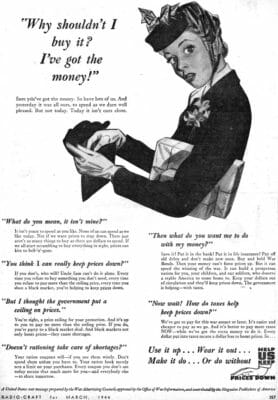At the beginning of the 20th Century, the United States was booming. The country had seen large growth following the Civil War and had entered a new age with the creation of labor laws and public works projects. Tough times were on the horizon, however, and the impacts would shape many generations.
In 1917, the United States entered World War I. Due to the men and horses being sent overseas to fight, the agricultural industry suffered. To make sure that the troops fighting had the supplies they needed, Americans at home were encouraged to participate in “Meatless Mondays” and “Wheatless Wednesdays” in an effort to cut consumption. The public did their part in finding ways to deal with the shortages, and from this mindset came the first “Victory Gardens,” which were intended to take the strain off the agricultural industry while providing citizens the opportunity to raise their own foods.
Beyond the food shortages, the production of goods slowed and even ground to a near halt as able-bodied men left for the War. Women joined the workforce and starting working in factories, but the bulk of industry was now geared toward munitions and the production of goods for the men in the field. Shortages began to appear in every facet of life, from cloth production to items made from aluminum. It was during this time that Calvin Coolidge was quoted as saying “Eat it up, Wear it out, Make it do, or Do without” (Later, the phrase became more popular with, “Use it up.”)
Get Free Electricity — And Never Be Without Power!
America didn’t have long to wait, and in 1918 World War I ended. Fighting men returned and many women returned to their homes. Items that had been funneled for the war effort now went back into the economy, and industries which had been on hold or diverted once again were in production.
 During the decade that followed, the United States saw much change – unionization, the first commercial radio station, the 19th Amendment which gave women the right to vote, the first motion picture with sound. America, it seemed, had bounced back from its brief time in the war and was a place of prosperity.
During the decade that followed, the United States saw much change – unionization, the first commercial radio station, the 19th Amendment which gave women the right to vote, the first motion picture with sound. America, it seemed, had bounced back from its brief time in the war and was a place of prosperity.
The year 1929 would change all that with the collapse of the stock market and the beginning of the Great Depression. In the four years following the collapse, unemployment rose from 3 percent to 25 percent, causing many families to lose their homes and farms. During the same stretch of time, drought in the Midwest caused the “Dust Bowl.” This created a perfect storm of limited food production, and when food was available, few people had the finances to afford it.
Families adopted new strategies to survive. The frugality of World War I now became about survival and not about patriotism. Some families migrated throughout the country looking for work, and accepting any wage they could, just to survive. Those that were able to stay in their homes once again embraced the “Victory Garden” ideals and raised whatever food they could. There was no money for items such as shoes or clothing. Everything was used until it just couldn’t be used anymore.
News stories began to use a variation of the phrase once uttered by Calvin Coolidge. “Use it up, wear it out, make it do, or do without” appeared in stories and on posters, urging the public to make do with what they had on hand. People darned their socks when holes appeared; aluminum foil was cleaned and saved for reuse; worn-out soles on shoes were replaced with pieces of leather or cut from old tires.
With the election of FDR and the creation of the New Deal, new agencies were created to provide jobs and assistance to the American people. Although the country began to recover, it was really the bombing of Pearl Harbor and the United States entering World War II that ended the Depression.
Although the increased demand for the goods necessary for the war effort put many people back to work and sent able-bodied men off into the Armed Forces, the frugality required by those at home did not end. Food shortages and food rationing both began very quickly. As the War continued, rationing of gas, clothing, shoes, tires, fuels and coffee all became commonplace. Recycling also came about during this same time, as the Government scrambled to conserve and recycle metals and rubber.
After the ending of World War II, service men and women returned home, and Americans entered an economic boom. The generation that had survived World War I, the Depression and World War II would not, however, be so easy swayed by the so-called “Golden Age of Capitalism.” These men and women had learned valuable lessons about the fragility of the U.S. economic system and for most, would hold on to those lessons for the rest of their lives.
Did you know anyone from this era? Let us know your stories about frugality in the section below:
 Off The Grid News Better Ideas For Off The Grid Living
Off The Grid News Better Ideas For Off The Grid Living




